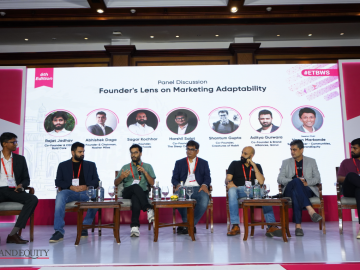COVID-19 has disrupted markets and accelerated digital adoption but what does this mean for the future of marketing? In this feature, Grünenthal’s Florent Edouard and Kate Hurtig outline their principles for a new pharmaceutical marketing model.
“Keith, Kotler, Maslow” has long been the Holy Trinity of pharma marketing. Great ancient thinkers all aspiring marketeers were taught to learn and respect, and to whom the smartest among us learnt to often refer to. This could be through a wise quote cracked in a meeting to give the right gravitas to any challenged proposal. ‘If Maslow said so, who dares challenge my proposal?’
And the fact is, for a long time, it worked.
The whole pharmaceutical marketing model was built on these founding principles, and delivered year after year blockbuster successes. Fortunes were made, careers were built, and junior marketers became senior vice presidents by paying tribute to the Holy Trinity principles. The innovation they brought, the science they used, and their broad vision shaped a framework that could be delivered immensely.
But the worm was in the fruit, as, even in the US, pharmaceutical companies struggled to transform the market into a consumer good market model. As a consequence, things turned sour when the payers progressively became immune to non “real world data” based evidences and started to challenge the reality of the health benefits while cutting spend. Pharma was quick to react though and specialty care, a space where science can be paid for, became the place to be. The R&D focus began to shift, and so did the marketing.
“Thankfully, some mavericks had been preaching for years that the future was digital, and so, albeit with limited budgets and support, some marketeers had already explored alternative channels and approaches for pharma marketing”
Away from the Holy Trinity principles, ‘Launch Excellence’ became paramount and the patient was the new focus. They had to be nurtured and cared for, despite the fact we, as pharma companies, have very limited direct access to patients.
Ethically, this patient focus became our shield against any criticism, especially when it came to the emerging horror stories of past unethical marketing practices. We knew we could serve patients better with emerging technologies, patient communities, and adherence apps. We could deliver innovation and receive industry awards for groundbreaking technology – everything was fine.
But fine is not good enough for financial markets and investors, and this slight model evolution was not enough to keep the sales growing at the expected rates. However, every year we kept repeating the decaying marketing approaches of the past – hammering the decision makers with repetitive messages, based on no true insight and created with less money, delivered by fewer people, and through only one or channels based on what the company preferred. Predictably, with fewer people and fewer channels to deliver our messages we had less impact. Our audience became bored and began to negatively judge our interactions.
But then, in 2020 the COVID-19 crisis hit the world and any remnants of this old model blew up. Suddenly, access to HCPs was cut and there was no way to deliver important messages the way we used to. If marketing is the art and science of making selling easy, was this the end of marketing altogether?
Without any access to our customers, what were we useful for? Should we just pack and go, or was there an unseen, unexploited opportunity we could build on to reboot our approach to marketing entirely and truly meet our customer needs?
Thankfully, some mavericks had been preaching for years that the future of marketing was digital, and so, albeit with limited budgets and support, some marketeers had already explored alternative channels and approaches to do pharma marketing.
But “digital” alone is not enough. Digital on its own is “just a channel” and we must think bigger- we must go back to basics and look at the problem with fresh eyes, using all we have learned from the last years of diminishing impact and the new rise of digital accelerated by COVID-19.
So, today we share with you what we think should be the cornerstones of new pharma marketing – reborn from the ashes of the COVID-19 pandemic and in tune with the evolution of technology and society.
Principle 1: Be customer centric. For real.
First, everything we do needs to be customer centric – not as a tick box exercise, but as a deep transformation. Historically, marketing excellence has been very product-driven. But that approach has fallen short of delivering coherent and high-quality customer experiences due to internal competition between brands, franchises, business units, etc. The outcome has been like an Apple customer receiving competing commercial messages from the app store, movie store, Apple watch, laptop, phone, etc. This type of top-down messaging is annoying and redundant and did nothing for the needs or habits of the HCPs. Instead, it resulted in access restriction and pure Share of Voice fight, so neither added-value nor image improvement.
Therefore, our industry, which dedicates billions of euros and millions of workers to save lives, has a negative Net Promoter Score and an image closer to the tobacco or weapon industries. We have alienated ourselves, our customers, the patients, the public and the authorities, and if we want to be in a better place, we need to rethink the whole model and take it from outside to inside.
What are the experiences we want to create for our customers? What do we want them to know, feel, understand about our products so they can become better at what they are doing while receiving those elements in the way they want?
This has deep consequences:
- We need to strengthen our analytics to be able to really understand our customers, rethink the way we do primary and secondary market research, the way we collect and process the data on our customers.
- We need to love our customers more than our products and place their safety and interests above everything else.
- We need to revise the way we conceive our marketing; the existing patient journeys are of course a must that need to remain at the core, but we now need to think how we can deliver for each individual customer the journey that will enable them to learn and perfect their practice.
- We need to create new capabilities, and we need customer managers, who understand their customers deeply and know how to deliver them the appropriate experiences. We need data to do this, but true insight is found when data meets curiosity and an open mind. Our marketers of the future must be these people, who get out of bed in the morning to connect ideas, have ‘aha’ moments and then very quickly make them real.
As you can see, becoming truly customer centric is not equivalent to writing it in your values and then doing a few webinars with experts. It requires a change of skills, mindset and behaviours that impacts us all.
Principle 2: Take a swim in your data lake every morning
If social media can be used to influence a presidential election, as shown by Sinan Aral in his great book “The Hype Machine”, why do we still see some “Our next blockbuster” product launch plans so reliant on past experiences? The reason is historical, technical and human.
Historically, pharma has always been very siloed, and structured data was power. Data was used to push personal, or departmental agendas, and the management was for a long time opposed to creating a single source of truth, encompassing all the enterprise data. Consequently, the commercial teams would never have access to the detailed R&D data or the production data, making it impossible to have an end-to-end management of the product life cycle based on a common dataset.
Even when the willingness was there, it was just technically impossible. The technology for Big Data has long been clunky, super expensive and very slow to setup, which was a poison pill in companies where the average turn-over of a management position is three years and projects like this rarely survive their initiators.
When you finally managed to have your data, you would then discover that it was fragmented all over the company, so dirty it was barely usable for anything and not worth the millions invested in getting it together.
And even if you managed to get a clean dataset, there was not the capability to use it. The average Analytical culture in Commercial functions is very low, all good data scientists are working in the R&D departments and the most complex statistical analysis most people understand is correlation. An over reliance on HIPO (Highest Income Person Opinion) in decision boards usually makes the purely data driven decisions quite rare.
But there is hope. What we see today is first a generalisation of clean data lakes. The technology is finally there, and we can connect all the data sources in a clean, single point, so that it can be extracted, cleaned and structured in a usable way.
“Our belief is that AI will play a key role in the future of marketing, and we would highlight two applications that will change the game.”
What is different is that today we share cloud-based infrastructure and tools with non-pharma companies, like FMCG. And those companies come with a far stronger analytical culture, better capabilities, better data exploitation tools and teams of experts we can tap into to enrich our own practices.
As we go for a world where we will deliver against our customer habits and appetites as to how and when they want to consume a content they are interested in, and no more a one size fits all message across all of them, we see an explosion in the data volumes and granularity. We can now very precisely know what each of our customer has seen, what they have done and what they are interested in, how they want to receive it etc. and we can finally address those needs. This change of mindset, as well as practice, makes us closer to any FMCG model, a B to C model where we finally treat each HCP as an individual.
Of course, the human dimension of this transformation is the hardest of all. The marketeer of tomorrow needs to understand data, needs to use data not only to generate insights but also to deliver the customer experiences that work. They need to be hungry for more data, always thinking out of the box how to enrich the data stack with actionable elements and stop relying on very high-level market research. Ultimately, the marketing insights of tomorrow will be generated by combining the terabytes of data we collect, through advanced analytics that will detect patterns in the data and will alert the humans on the opportunity just detected, and then use our human minds to seek the human behavioural element behind that. Once we combine data-driven and human behavioural insights, we can really understand what we can do.
Principle 3: In AI we trust
One of the many challenges coming with a data-based future is the human limited capacity to compute big data sets into rapid actions. And one great solution to this is the tactical implementation of artificial intelligence. It is fascinating to listen to people talking about AI, as there are so many misconceptions about how it should be used.
Our belief is that AI will play a key role in the future of marketing, and we would highlight two applications that will change the game.
First, the famous Next Best Action. It is now proven that using AI to go through our marketing mix, on a clean data stack and in a system where all our channels (face to face, web, email, webinars etc.) are interconnected allows the system to understand precisely what the customer wants, and to give it to them.
That is the core of all recommendation algorithms and can be used for the worst, but also for the best. They can create great customer experiences at a very detailed level – each interaction – without overloading the company employees with hundreds of thousands of small decisions. It literally is going from the Ford T to the Tesla car. This is real today, at small scale, and will become the norm tomorrow in healthcare.
Second, what we would call the Nessie project. Like the famous monster of the Scottish lake, we can now have AI browsing through the lake, permanently looking for patterns, new ones, broken ones, any kind of changes that would indicate the market is moving, the customers are changing, and turn that into an alert humans can look at and potentially exploit. It is the automated generation of data-based insights, that will create the business opportunities of tomorrow.
What we see in both of those cases, is that we are not talking about replacing humans by artificial intelligence. What we foresee is ‘augmented intelligence’, where the marketeer will do what humans are good at: bringing new perspectives, bringing together elements that seem totally unrelated, adding the human factor into the analysis, and driving the future actions at big scale. But to do so we need to completely revolutionise our culture, working habits, and our capabilities to get there.
Principle 4: It’s all about culture.
This cultural aspect of the future of marketing is the biggest enabler, and the biggest challenge of all. Pharma has been successful because the environment is so regulated. We are used to long and thorough processes to discover, test and get approved expensive products so we struggle being agile and entrepreneurial.
Innovation cultures have natural tension between two seemingly opposing behavioural forces, articulated by Gary Pisano in his article The Hard Truth about Innovation Cultures.
Innovation needs five things:
- Tolerance for failure, but not tolerance for incompetence
- Willingness to experiment, but highly disciplined
- Psychologically safe but brutally candid
- Collaboration but with individual accountability
- Flat but strong leadership
Only by managing these tensions, and role modelling them from the top, and at the same time creating grassroots “movements” within the brand and customer teams, can pharma get out of its own way and allow innovation to occur in our business model, as well as in our R&D group.
The key decisionmakers have been very successful building careers with a specific paradigm, and they doubt the world has fundamentally changed. It is our role as marketeers to lead them through the changes happening, so that they can role model the behaviour of tomorrow. If teams see senior leaders sharing their own mistakes and learning, if our marketing juniors can feel that they are trusted, empowered to innovate, that they can challenge the status quo and the established methods and tools, then they will unleash their creative mind. Psychological safety is a must for an organisation to innovate daily, beyond controlled pilots.
Of course, this must be accompanied by a massive learning and education program, that makes all of us better at understanding this new world and technologies. As we build confidence in using them we can then focus on what matters the most: the customer experiences we are creating.
In addition to this, our strategies will become purposeful and our motivation will go up. Because of our pride and passion, the marketing of the future will be better for all, not just the pharma company, but also the HCPs and ultimately the patients who will get the right treatment administered in the right way.
This future starts now.
About the authors
Florent Edouard is the global head of commercial excellence at Grünenthal Group, a pharmaceutical company headquartered in Germany and specialised in pain. Coming from AstraZeneca, where he led multiple commercial functions including four years in charge of AZ Respiratory and GI franchise in Japan, he joined Grünenthal in 2017 to drive the company’s commercial transformation, from Launch Excellence to Field team impact, through Analytics uplift as well as platform and capability build across affiliates.
 Kate Hurtig currently heads up global marketing at Grünenthal’s group, and is keen to inject the voice of customers and patients who are struggling with the problem of poorly managed pain into everything we do, so that together we can help reduce pain in the world. Kate brings with her a passion for creative problem solving, deep curiosity for how our brains (and the brains for our customers!) actually work, and experience in marketing and in the pain therapy area.
Kate Hurtig currently heads up global marketing at Grünenthal’s group, and is keen to inject the voice of customers and patients who are struggling with the problem of poorly managed pain into everything we do, so that together we can help reduce pain in the world. Kate brings with her a passion for creative problem solving, deep curiosity for how our brains (and the brains for our customers!) actually work, and experience in marketing and in the pain therapy area.





